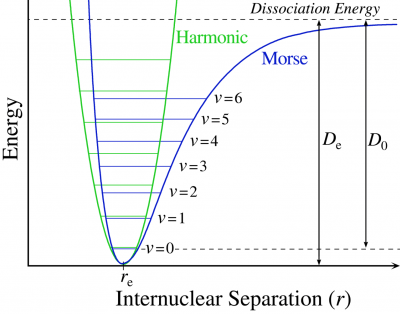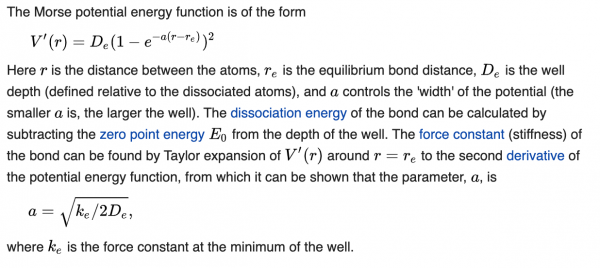Difference between revisions of "PCh8 Lec2"
| Line 10: | Line 10: | ||
We can finish this section by looking closely at Table 8.3. Here is what you know: | We can finish this section by looking closely at Table 8.3. Here is what you know: | ||
| − | 1) the value for the ''ṽ<sub>o</sub>'' (forbidden) is determined by the gas phase IR spectrum. | + | :1) the value for the ''ṽ<sub>o</sub>'' (forbidden) is determined by the gas phase IR spectrum. |
| − | 2) the value for the ''ν'' is calculated, ν = ṽ<sub>o</sub> * speed of light in cm/sec. | + | :2) the value for the ''ν'' is calculated, ν = ṽ<sub>o</sub> * speed of light in cm/sec. |
| − | 3) ''x<sub>e</sub>'' is the equilibrium bond length that can be calculated from the IR data...you did this with HCl. | + | :3) ''x<sub>e</sub>'' is the equilibrium bond length that can be calculated from the IR data...you did this with HCl. |
| − | 4) ''k'' is the force constant; you calculated this in last lecture using reduced mass and ''ṽ<sub>o</sub>'' | + | :4) ''k'' is the force constant; you calculated this in last lecture using reduced mass and ''ṽ<sub>o</sub>'' |
| − | 5) ''B'' is the rotational constant you calculated using the IR data for HCl. | + | :5) ''B'' is the rotational constant you calculated using the IR data for HCl. |
| − | 6) ''D<sub>o</sub>'' is listed in this table, but i am not sure how this was determined...sorry. | + | :6) ''D<sub>o</sub>'' is listed in this table, but i am not sure how this was determined...sorry. |
==Section 8.4== | ==Section 8.4== | ||
Revision as of 16:35, 27 March 2020
Section 8.3 (cont.)
So, one of the things that we have not full acknowledged is that the harmonic oscillator potential of 1/kx2 is not really the actual potential...it is close, but not completely accurate. Figure 8.6 (similar to below) compares the 1/2kx2 potential to a potential referred to as the "Morse potential." The Morse potential is also referred to as an anharmonic potential. The Morse potential is one type of anharmonic potential, some fundamental research projects seek to refine the form of the "true" anharmonic potential.
If you recall originally solving the Schrodinger equation with the "harmonic" potential, the energy separation between the levels was the same, but with the Morse potential the energy result is slightly different leading to the energy levels getting closer together as we move up in the levels. Additionally, the harmonic potential did not acknowledge the fact that we can break the bond (the harmonic potential was infinitely high); the Morse potential takes bond breaking into account.
The following is taken from the "Morse potential wikipedia page", if interested, you could play with this function in Mathematica; manipulate "a"...
We can finish this section by looking closely at Table 8.3. Here is what you know:
- 1) the value for the ṽo (forbidden) is determined by the gas phase IR spectrum.
- 2) the value for the ν is calculated, ν = ṽo * speed of light in cm/sec.
- 3) xe is the equilibrium bond length that can be calculated from the IR data...you did this with HCl.
- 4) k is the force constant; you calculated this in last lecture using reduced mass and ṽo
- 5) B is the rotational constant you calculated using the IR data for HCl.
- 6) Do is listed in this table, but i am not sure how this was determined...sorry.

